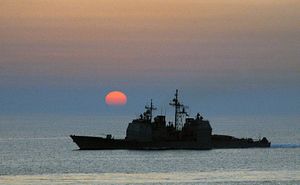Last month, a U.S. Navy destroyer carried out the first freedom of navigation operation (FONOP) in the South China Sea since President Donald J. Trump took office in January, asserting high seas freedoms around Mischief Reef in the Spratly group, the site of a Chinese artificial island. The operation was also the first since the USS Decatur carried out a FONOP in the Paracel group in the South China Sea in October 2016, marking the longest break between two FONOPs since the U.S. began operations near Chinese claims in the South China Sea in October 2015.
As Robert Farley reflected in these pages (and as several other South China Sea-watchers have pointed out), FONOPs in the South China Sea receive a fair bit of attention, owing to the fact, in part, that China tends to react publicly and negatively to each operation. FONOPs are also seen as one of the few low-intensity tools the U.S. Navy has in the South China Sea to shore up international norms. For all of this, however, the five FONOPs in the South China Sea since the USS Lassen kicked things off in October 2015 have seen their fair share of public debate about a range of issues, including everything from their effectiveness to the specifics of what legal claims were challenged.
The U.S. Navy and the Department of Defense have, in part, made this easy by pursuing a mixed communications strategy around these operations. The Lassen operation was famously muddy about what claims were challenged and why — at least until then-Secretary of Defense Ash Carter came out in a letter to the Senate to clarify matters. The other three operations carried out under the Obama administration were followed by leaks in the press, clarifying certain matters about the specifics of what claims had been challenged. DoD, meanwhile, stuck to its practice of releasing its annual public report on freedom of navigation, which clarified that the FoN program was about far more than just Chinese claims or even Chinese claims in the South China Sea.
For all the hubbub about FONOPs, comparatively less attention has been given to the U.S. Navy’s regular presence in the South China Sea. U.S. Navy vessels continue regular patrols in the area — albeit outside the 12-nautical-mile zone of disputed features. As a recent report in the Financial Times, citing Admiral Scott Swift, the commander of the U.S. Pacific Fleet, makes clear, the U.S. Navy is hoping to make its presence in the South China Sea do as much for the objective of challenging Chinese maritime claims in the area as the acute FONOPs.
Swift notes that while FONOPs will continue, they will occur quietly. “I think it’s a very positive step that current policy… is that we’re not going to talk about freedom of navigation operations in the South China Sea,” he told the FT. Swift did not clarify any other details about the Dewey‘s operation last month, despite leaks in the press that helped clarify the specific nature of the high seas assertion conducted in the operation. On presence, Swift told the FT, notably, that the number of days U.S. ships will spend in the South China Sea would exceed 900 in 2017 going by current rates — much higher than a “long-term average of 600-700 days.”
Speaking softly and showing up seems to be the new game for the U.S. Navy in the South China Sea. Secretary of Defense Jim Mattis also made a point of emphasizing that the U.S. military would “demonstrate resolve through operational presence in the South China Sea and beyond” in his speech at the Shangri-La Dialogue earlier this month. “Our operations throughout the region are an expression of our willingness to defend both our interests and the freedoms enshrined in international law,” Mattis added.
Mattis echoed his predecessors when he said that the U.S. Navy would “fly, sail and operate wherever international law allows.” In 2017, though, the United States may see the advantage of showing China that it means this through an increased regular presence in the area.

































